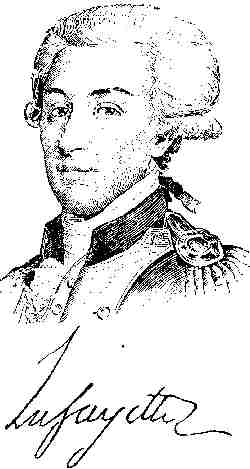
September 5, 2007

The name game is played daily. One word, “Lafayette,” which can be translated from the French as “the little fairy” or “the little enchantment,” is an especially fascinating focus, my friends.
This specific element of the name game that Jim Brandon wrote about in Weird America, and that I have discussed in Mysterious America, is what I’ve come to call the “Fayette Factor.”
Since research and writing about it first in the 1970s, several items on this lexilink between Fayette (as well as its related forms – Lafayette, La Fayette, Fayetteville), high strangeness and sightings have been published.
The cities, towns, and counties across the United States, which are the Fortean hotspots linked to the Fayette Factor, are tied to the renamed Masonic lodges and affiliated sites that the Marquis de Lafayette visited on his grand tour of the country in 1824-1825. His visits were highly ritualized happenings, in which he was involved with laying many cornerstones and other ceremonies. The locations where he was taken to visit are a virtual roadmap of the “special places” in this land.
The United States of America will display a rare overt replaying of these events linked to several special locations, because the 250th birthday of the Marquis de Lafayette is on the horizon.
For those interested in the unfolding of this twilight language, you may wish to take some notes in the next three weeks.

September 6, 2007, marks the 250th birthday of the Marquis de Lafayette, and more than a dozen French and American communities—including the Pennsylvania college that bears his name—will hold grand celebrations honoring the life and legacy of the French citizen and hero of the American Revolution.
Cities and towns from Lafayette, Louisiana, to Fayetteville, North Carolina, are planning gala events the first week of September. “There are more than two-dozen cities and towns named after Lafayette,” says Diane Windham Shaw, Lafayette College’s archivist, “as well as a river in Virginia and a mountain in New Hampshire.” She notes that there are also many U.S. communities named LaGrange, in honor of the Marquis de Lafayette’s ancestral home.
While many Americans are aware of Lafayette’s contribution to U.S. independence, Shaw points out, few recognize his commitment to ending slavery in America. She notes that his ardent opposition to slavery seems to have been an outgrowth of his experiences fighting for American liberty. Shaw has studied many of the letters Lafayette wrote to his close friend, George Washington, including more than 150 held in the college’s archives, which contain the 1783 letter containing Lafayette’s proposal to Washington about freeing slaves.
“At some point, late in the American Revolution,” she says, “Lafayette ceased to regard slaves as chattel, and embraced what was to become his lifelong commitment to equality for all men, regardless of race.” Shaw is a scholar of Lafayette’s legacy, and has served as an organizer of an online exhibit Lafayette and Slavery as well as an exhibit that represents a collaboration between the College and Mount Vernon: A Son and his Adoptive Father: The Marquis de Lafayette and George Washington. The exhibit is currently on display at Mount Vernon and will travel to Lafayette College, where it will be on view Sept. 6-October 8.
The centerpiece of the college’s year-long celebration will be a three-day event September 5-7 featuring a keynote address delivered by historian David McCullough, the dedication of a Pennsylvania historical marker, an encampment by Revolutionary War re-enactors, the arrival by carriage of a noted actor portraying the Marquis de Lafayette, carriage rides around campus, dinners, music and dance, and a lecture by Lloyd Kramer, award-winning author of the book Lafayette in Two Worlds: Public Cultures and Personal Identities in an Age of Revolution. Other notables, including Gloria Steinem and Salman Rushdie will offer presentations as part of the celebration later in the academic year.
“It is the college’s good fortune to be associated with an individual who was so deeply dedicated to freedom and liberty,” says Daniel Weiss, president of Lafayette College. “Lafayette’s life was a superb example of global citizenship and service.” More information about the naming of Lafayette College can be found at here.
In honor of the 250th anniversary of the Marquis de Lafayette’s birth on September 6, 1757, the renowned French design house Hermès is producing one of its famous scarves depicting the life of the Marquis and the connection he helped forge between France and the United States. A Lafayette College alumnus jump-started the initiative, and sales from the scarf project will be used by the college as a fund-raiser to benefit the campus library and the college’s art collection.
The scarf, designed by Texas artist Kermit Oliver, who has created the art for more than a dozen Hermès scarves, will be released in the fall to coincide with the September 6th “250th celebration.” The Marquis scarf is elaborate, colorful, and bursting with historical figures and symbols.

“I tried to keep the documented colors in terms of the costumes that were worn at the time,” he says, adding that the scarf’s vibrant red border is also in keeping with shades used at the time. “For both countries that was a very important, symbolic color.”
Prominent on the scarf is an image from Jean-Baptiste Le Paon’s painting Lafayette at Yorktown in the Lafayette art collection. Lafayette stands clutching his sword by his side in his left hand and pointing with his right hand. Holding the reins of his horse is the slave James Armistead, renowned for his service as a spy behind enemy lines who helped bring about the American victory at Yorktown.
Rising from the bottom border of the scarf are images of the Marquis as a young man and as the aging hero during his Farewell Tour of the United States in 1824-25.
Depicted on the border, in cameo images, are Benjamin Franklin and presidents John Adams, Thomas Jefferson, James Madison, James Monroe, and John Quincy Adams. Also depicted are Simón Bolívar, the “George Washington of South America,” who led revolutions against Spanish rule, and Toussaint l’Ouverture, a former slave who led the Haitian independence movement.
George Washington is shown on horseback fronting a 13-starred American flag and one of the many arches erected in his honor during the Farewell Tour. A map of North America showing the original 13 colonies serves as a backdrop in the main portion of the scarf, partially obscured by two golden, winged figures, which Oliver says appear in the War Drawing Room at Versailles.
For Oliver, designing a scarf is much like executing one of his intricate, meaning-layered paintings.
Hermès is a 137-year-old company that once outfitted horse-drawn coaches in Paris. It first introduced its scarf line in 1937 as the company expanded from a leather goods company into a lifestyle brand. Hermès releases about 15 new designs each year, which are made at a factory in Lyons, France. From an artist’s sketchpad to the final inspection, each scarf can take as long as two years to make and involve as many as 40 artisans.
Sources:Lafayette Alumni Communications Release, Lafayette Alumni News Magazine, Mysterious America, and Weird America.
About Loren Coleman
Loren Coleman is one of the world’s leading cryptozoologists, some say “the” leading living cryptozoologist. Certainly, he is acknowledged as the current living American researcher and writer who has most popularized cryptozoology in the late 20th and early 21st centuries.
Starting his fieldwork and investigations in 1960, after traveling and trekking extensively in pursuit of cryptozoological mysteries, Coleman began writing to share his experiences in 1969. An honorary member of Ivan T. Sanderson’s Society for the Investigation of the Unexplained in the 1970s, Coleman has been bestowed with similar honorary memberships of the North Idaho College Cryptozoology Club in 1983, and in subsequent years, that of the British Columbia Scientific Cryptozoology Club, CryptoSafari International, and other international organizations. He was also a Life Member and Benefactor of the International Society of Cryptozoology (now-defunct).
Loren Coleman’s daily blog, as a member of the Cryptomundo Team, served as an ongoing avenue of communication for the ever-growing body of cryptozoo news from 2005 through 2013. He returned as an infrequent contributor beginning Halloween week of 2015.
Coleman is the founder in 2003, and current director of the International Cryptozoology Museum in Portland, Maine.
Filed under Breaking News, Conspiracies, Cryptomundo Exclusive, Cryptotourism, CryptoZoo News, Cryptozoologists, Cryptozoology, Media Appearances, Pop Culture, Twilight Language